Talking about report cards at the National Conference on Ecosystem Restoration
Bill Dennison ·The fifth National Conference on Ecosystem Restoration (NCER 2013) was held near Chicago, Illinois July 29-August 2, 2013. UMCES was the local sponsor for the forth National Conference on Ecosystem Restoration in Baltimore, Maryland in 2011, and our name tag lanyards were beads to advertise that NCER 2015 will be in New Orleans. A new conference feature was introduced for the start of each concurrent session - a short exercise/stretching video (XBYTES) that was really fun and relaxing.
Heath Kelsey and Dave Nemazie from UMCES organized a session in NCER 2013 on environmental report cards. The topic was popular and 8 report card talks were submitted, so we opted to chair the session and not present an IAN talk. UMCES had a booth at the conference that featured many of the report cards that IAN has produced and several of the talks were by active IAN partners, so the IAN report cards were available to conference participants by other means than a PowerPoint presentation.
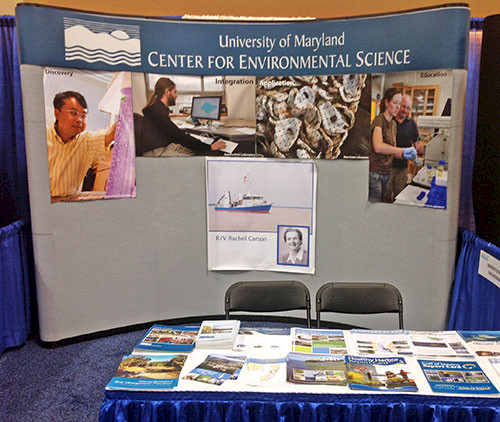
Scott Sowa from The Nature Conservancy (TNC) represented a broad spectrum of partners working on the Great Lakes, particularly Western Lake Erie. They were asking the question "How much is enough in terms of conservation actions?", and using a Conservation Effects Assessment Project (CEAP) to address this question. Scott used a Performance Indicator Pyramid, rather than the original TNC approach of "bucks and acres". The pyramid base was resource inputs and costs, with conservation actions above, and then habitat outcomes and biological outcomes on top of that. The peak of the pyramid was social benefits. In phase 1 - they linked fish community health to predicted water quality conditions; in phase 2 - they linked conservation actions to water quality and fish; and in phase 3 - they developed online decision tools to provide context, target and track progress. Using this approach, they identified the implementation costs of achieving certain ecological outcomes in some areas, and identified areas where desired outcomes could not be achieved. In those areas, Scott recommended revising (lowering) expectations, or obtaining significantly more resources, or innovating to achieve more cost effective results.
Mark Monaco from NOAA presented three examples of report cards that NOAA scientists participated in. The Coral Reef Conservation Program (CRCP) produces a State of the Reefs assessment of coral reefs in US states and its territories. These assessments use both quantitative data and expert opinion, and a stoplight color scheme is used for communicate results. Mark also presented results from the National Estuarine Eutrophication Assessments (NEEA) in 1999 and 2007. IAN partnered with Suzanne Bricker for the 2007 assessment, resulting in a publication and website. Mark used NEEA to provide context for a study that his group is working on in Long Island Sound. They are testing whether or not Connecticut-based aquaculture could ameliorate the nutrient impacts in Long Island Sound. The final example that Mark used was the condition assessment of National Marine Sanctuaries. The fourteen National Marine Sanctuaries are generally in fairly good condition due to their locations distant from terrestrial sources of runoff. Interestingly, they also include archeological sanctuaries as well as ecosystem sanctuaries. The process they are using is a three step process; 1) upfront planning, 2) integration of existing data and 3) a combination of quantitative and expert opinion for the assessment. The common themes of these three types of NOAA assessments are a combination of quantitative and expert opinion, use of stoplight colors, and an attempt to communicate results to broad audiences.
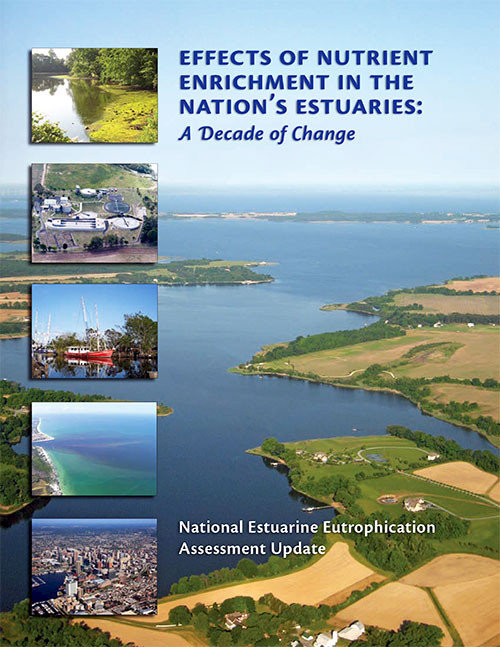
Wes Tunnell from the Harte Research Institute, Texas A&M talked about the Gulf of Mexico report card. In addition to Wes and Larry McKinney from the Harte Research Institute, Mark Harwell and Jack Gentile from Harwell, Gentile & Associates have teamed up with IAN to develop the vision for the Gulf of Mexico report card, which Wes outlined. Wes highlighted the key question that motivated their foray into reports cards: "If you do not know where are going or where you are, how are you going to know when you get there?"
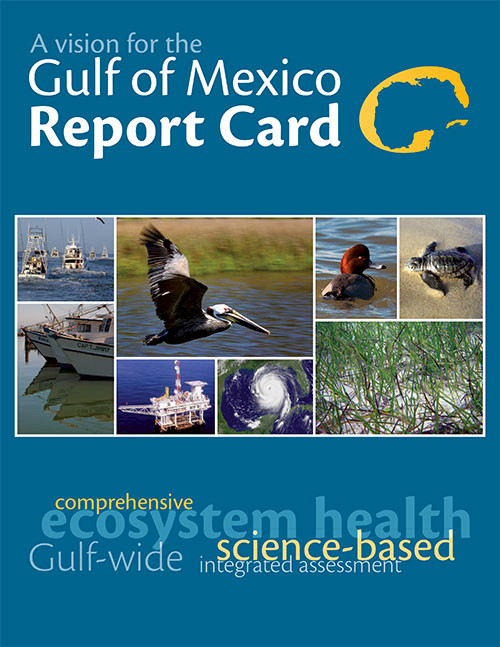
Harald ‘Jordy’ Jordahl from America’s Watershed Initiative and The Nature Conservancy talked about the Mississippi River Basin report card effort. IAN is part of the diverse team tackling this report card effort over a massive watershed that includes parts of 31 U.S. states and 2 Canadian provinces. Jordy used a photo of farm silos to emphasize the various different sectors (e.g., flood protection, agriculture, water supply, energy and industry, navigation, recreation and environment) that comprise the Mississippi River basin. Jordy also highlighted the diverse steering committee, including the Army Corps of Engineers, state and municipal government, Caterpillar, soybean growers, barge operators, and The Nature Conservancy. He also talked about what report cards can and, also importantly, cannot do. For example, reports cards can report status and trends and engage different communities, but cannot report on a single management policy.
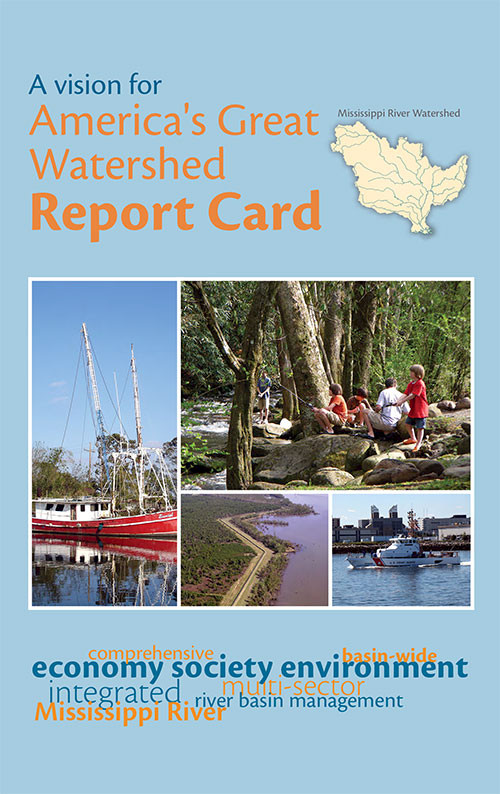
Ann Hijuelos from The Water Institute of the Gulf talked about developing a report card for coastal Louisiana, tracking the implementation of the 2012 Master Plan for coastal Louisiana. She held two workshops to discuss ecological/environmental measures and socio-economic measures. These workshops identified indicators that can be integrated into measures of sustainable landscapes and resilient communities. Focus group sessions around the state of Louisiana were also used to elicit feedback on the report card. I have been involved both as a reviewer of the 2012 Master Plan and as a consultant to The Water Institute of the Gulf, and an IAN style approach is being adopted for this report card effort.
Laura Brandt from US Geological Survey/US Fish & Wildlife Service talked about a report card for the Florida Everglades. The water flow diversions that are occurring as part of the Florida Everglades restoration effort have stimulated this report card effort. They selected a suite of indicators with a focus on animals (fish and wildlife) in 2005 and produce biennial assessments using a stoplight color scheme. The current effort is to standardize (more consistency, standard water year reporting cycle, location names) and to integrate (between indicators and between different regions).
Merrie Carlock and then Brandy Siedlaczek from Southfield, Michigan provided successive talks about the Rouge River restoration effort. The Rouge River flows through Detriot and the automotive industrial region (“We like pavement and cars” was Merrie’s quote), and has been the focus of an extensive restoration effort accompanied by intensive monitoring. The development of public access and interpretative signage has provided increased awareness, and they are considering ways to develop report cards to augment this effort.
We had good report card discussions after the talks and over lunch. The question of how to maximize the ability of report cards to achieve good conservation outcomes was kicked around. Since report cards are of a scale that can be relatively large (e.g., Gulf of Mexico or Mississippi River Basin), but conservation efforts are at relatively small scales (e.g., river restoration, agricultural practices), it can be difficult to transcend this divergence in scale. We discussed using nested scales of reporting, including employing citizen scientists at the local scale. The importance of getting people into the room talking about a reporting region was emphasized, since ecosystem management is about people building relationships, and report cards are viewed as a way to achieve this relationship building. The idea of getting people into a ‘solution space’ to start developing approaches to solve the problems that report cards help identify was also raised.
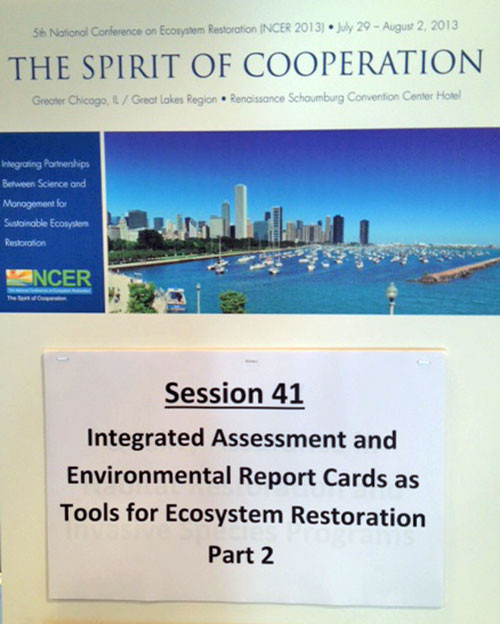
About the author
Bill Dennison

Dr. Bill Dennison is a Professor of Marine Science and Vice President for Science Application at the University of Maryland Center for Environmental Science.

